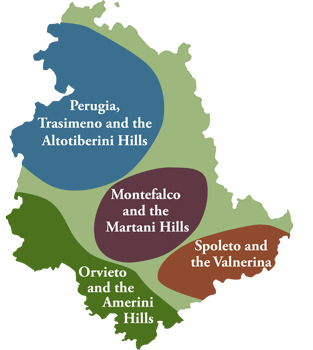
Some of the traditional dishes that define Umbrian cuisine

Appetizers (antipasti)

Salumi Misti (Mixed cured meats and cold cuts)
Umbrian tables usually start with a mixture of typical cold cuts, prosciutto, pork sausages, wild boar salami, and dried sausages. These meats are frequent paired with fresh cheeses such as local Caciotta umbra.
Crescia Ripiena
A dough made with eggs, water and lard which is typical of the province of Perugia and stuffed with salami, cheese or sauteed vegetables. Equally widespread, even in the southern part of the region is the Torta al Testo, a mixture of flour and water cooked slowly on the “testo” stone, then filled with ham, vegetables and salami.
Bruschetta all Olio di Oliva
The most common appetizer of toasted unsalted bread seasoned with a little salt, garlic and extra virgin olive oil. Simple and delicious!
Crostino di Fegato
A widespread and simple dish, made with unsalted bread crostini and a slightly vinegary liver pâté.
Pastas and First Courses (primi piatti)

Strangozzi e Umbrichelli
Typical homemade Umbrian pasta with a light taste because they are prepared with only flour and water. This long hand rolled pasta is prepared in different variations and goes well with vegetables, black truffle, and fresh tomato (“Spoleto”) based sauces. Terni’s variation is called “ciriole” pasta which has the same preparation, but is cut into thin squares.
Pappardelle
Another homemade pasta made with an egg dough, is cut into thick strips. Typically accompanied by meat based wild game sauces such as hare, and wild boar. There are also variations with rabbit and duck.
Tagliatelle
Similar to the pappardelle, but cut narrower, tagliatelle is widespread throughout the region. The traditional version of “norcina” with mushrooms and sausage or with chicken giblets. You can also find Maltagliati an irregular shaped egg pasta.
Quadrucci
Homemade square shaped egg pasta mainly used in soups.
Cappelletti
This homemade pasta is traditional at Christmas time. It looks similar to, but are larger than tortellini, and the name means little hat. These are wonderful in broth or with a tomato sauce.
Zuppe
Very common in Umbria are soups, including ones based on legumes (Trasimeno bean, chickpeas and chestnuts, beans).
Second Courses (secondi piatti)

Salsicce e Insaccati
Sausages are among the great protagonists of the table and of the traditional “norcina umbra.” Among the most popular are pork and wild boar sausages, prepared in different ways with black or spicy pepper, or dried. Salamis including “morbido di Norcia” (soft salami of Norcia), Salamini cacciatori DOP, Cojoni di Mulo, and corallina (made with select meat and fat cubes). Traditional pork meats are capacollo (or scalmarita), lardo (lard), sanguinaccio (made from pig’s blood, restricted and spiced with raisins, sugar and other flavorings), lombetto and prosciutto (typical Umbrian salted and aged meats).
Porchetta
Another typical dish of Umbria, slow roasted pork stuffed with fennel, fresh pepper and other spices.
Pork is widely used for the preparation of local specialties, such as mazzafegati salty or sweet (like sausages prepared with lean meat, liver and orange peel and raisins) or “tordomatto” (skewer made with pork tenderloin flavored with bay leaf and pepper).
Friccò
A term related to the culinary traditions of the northern area of the region in particular Gubbio. It generally refers to how to prepare main dishes of meat (usually white meat: chicken, pork, lamb), cooking them slowly in terra cotta pots .
Palomba o Piccione alla leccarda
A typical dish of Umbria, in particular Orvieto and of Amerino. This ancient traditional dish, is dove or pigeon cooked on a spit under this earthenware pot, filled with seasonings. The pot collects the fat that drips from the meat while cooking and mixes with the spices and flavors the meat.
Other meats that are prevalent in the region, such as Lamb and rabbit (one recipe called “porchetta” where it is stuffed with herbs and wild fennel) and beef of excellent quality like the Vitellone dell’Appenino DOP.
Cacciagione
Umbria, so rich in forests and green areas is also ideal habitat for wild animals like boar, which is the most common wild species. It is a meat easily found on menus of Umbrian restaurants and in typical food shops. The tasty meat of wild boar is used to make delicious sauces, stews, sausages and cold cuts.
Desserts (dolci)

Desserts and chocolates are common specialties in Umbria. Chocolate is a world renowned tradition of Perugia. Regional desserts are mostly local to towns and often tied to special holidays or events. Many desserts are similar to each other and created with simple and natural ingredients.
Torcolo di San Costanzo
A sweet bun with anise, candied fruit, pine nuts, and flour. Typical from the city of Perugia. Another similar dessert from Perugia is Brustengolo.
Fave dei Morti
Oval shaped cookie with almonds typically prepared in Perugia for the celebration of All Saints. Tozzetti have a similar taste and are also made with almonds. They are often accompanied by the liqueur Vinsanto at Umbrian tables.
Maccheroni Dolci
Typical Christmas macaroon prepared with cocoa, cinnamon, nuts and some versions with honey.
Crescionda Spoletina
A soft dessert composed of three layers: a bottom formed by macaroons and flour, the center with a light pudding, and top with chocolate. The Spoleto area has Attorta, another dessert with cocoa and nuts. Todi’s variation is called Nociata.
Mostaccioli
A common Umbrian dessert, and often prepared for the Christmas holidays. It is made with wheat flour, sugar, white grape, anise seeds, raisins, olive oil, yeast, and orange peel.
Pampepato
Typical of Terni, a dessert with a cocoa, and pleasantly spicy due to the pepper used in the dough.
Castagnole – Strufoli
Typical during carnival, served with honey.
Torta di Pasqua Dolce
This dessert is traditionally prepared for Easter. In the form of panettone, this version is prepared dessert with cinnamon. There is also a savory version is made with cheese.
 Wine Production
Wine Production Wine Tastings
Wine Tastings Restaurant
Restaurant Wine Retail
Wine Retail Products Retail
Products Retail Bio Production
Bio Production Beer Production
Beer Production